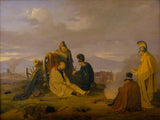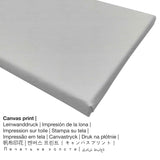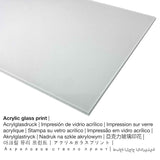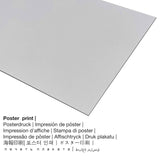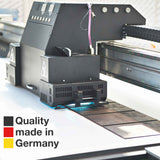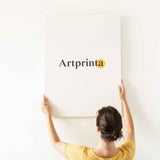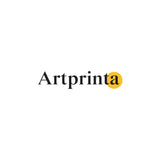Jørgen V. Sonne, 1833 - Ọgbọ agha n'ụtụtụ mgbe agha ahụ gasịrị - ọmarịcha nka.
Ụtụ gụnyere. Mbupu gbakọrọ na ndenye ọpụpụ.
Họrọ ụdị ngwaahịa ngwaahịa gị
N'ime ndetu ndetu ngwaahịa ị nwere ike ịhọrọ nha na akụrụngwa ọkacha mmasị gị. Anyị na-ahapụ gị ka ịhọrọ nha na akụrụngwa ọkacha mmasị gị n'etiti nhọrọ nhazi ngwaahịa ndị a:
- Ebipụta akwụkwọ mmado na ihe akwa akwa: Our poster is a printed flat canvas paper with a nice finish on the surface, which reminds the original artwork. Please keep in mind, that depending on the absolute size of the poster print we add a white margin 2-6cm round about the artwork to facilitate the framing with your custom frame.
- Mbipụta ọla (aluminium dibbond): This is a metal print made on aluminium dibond material with a true effect of depth. The print on Aluminum Dibond is the most popular entry-level product and is a truly sophisticated way to showcase fine art reproductions, because it puts all of the viewer’s attention on the artwork.
- Mbipụta kanvas: The canvas print, which should not be mistaken with a painting on a canvas, is an image printed from a UV direct printer. It makes a particular impression of three dimensionality. A canvas of this artwork will let you turn your individual fine art print into a large size collection piece as you would see in a real gallery. Canvas Prints have the great advantage of being relatively low in weight, which means that it is quite simple to hang up the Canvas print without the support of extra wall-mounts. Canvas prints are suitable for all types of walls.
- Glass acrylic ebipụtara nwere mmetụta na-egbuke egbuke: The acrylic glass print, often labelled as a print on plexiglass, will convert the original artwork into wonderful home décor and is a viable alternative option to canvas or dibond fine art replicas. The artwork will be made with the help of modern UV direct print technology. The special effect of this are impressive, vibrant colors. The major advantage of a plexiglass print is that contrasts and also details become more visible with the help of the fine tonal gradation in the picture.
Disclaimer: We try in order to describe the art products in as much detail as possible and to exhibit them visually. However, the tone of the print materials, as well as the imprint may diverge marginally from the image on the device's monitor. Depending on the settings of your screen and the quality of the surface, not all color pigments are printed one hundret percent realistically. In view of the fact that all our art prints are processed and printed manually, there may as well be slight deviations in the exact position and the size of the motif.
Nkọwa ihe osise izizi dị ka ewepụtara site na webụsaịtị ihe ngosi nka (© - Thorvaldsens Museum - Ụlọ ihe ngosi nka Thorvaldsens)
Sonne is undoubtedly one of the standard bearers of National Romanticism, but A Battlefield the Morning after a Battle was painted in Rome in 1833 after Sonne had just completed several years of study at Munich. Nor is the motif Danish. It is about Bavarian soldiers who have set up camp in the open air during the Napoleonic wars. Sonne returned from his travels abroad in 1841, and in 1844, the art historian N. L. Høyen gave the lecture – On the Conditions for the Development of a Scandinavian National Art – which really gave the impetus to National Romanticism. It was only as a result of this that Sonne was won for the national cause, which not least was seen in battle scenes from Dybbøl (1848) and Isted (1850), where Denmark came out well. On the other hand, the defeat in 1864 scarcely held the same attraction for the patriotic Sonne.
Ozi gbasara ngwaahịa nka a
N'elu 180 year-old masterpiece was made by the painter Jørgen V. Sonne in 1833. Nke kariri 180 Original dị afọ nwere nha: 59,5 x 79,8 cm ma jiri ya rụọ ya mmanụ na kwaaji. Taa, ihe osise a na-etolite akụkụ nke Ụlọ ihe ngosi nka nke Thorvaldsens digital collection, which is a single-artist museum dedicated to the art of Danish neoclassicistic sculptor Bertel Thorvaldsen. With courtesy of - Jørgen V. Sonne, A battlefield on the morning after the battle, 1833, Thorvaldsens Museum, www.thorvaldsensmuseum.dk (ikikere: ngalaba ọha).: . Ọzọkwa, nhazi nke mmepụta dijitalụ dị na odida obodo format ma nwee oke nke 4: 3, nke pụtara na ogologo bụ 33% ogologo karịa obosara.
Nkọwa gbasara ọrụ nka
| Aha eserese: | "A battlefield on the morning after the battle" |
| Nhazi: | sere |
| Okwu mkpokọta: | nkà nke oge a |
| Century: | 19th narị afọ |
| Emepụtara na: | 1833 |
| Afọ nka: | karịa afọ 180 |
| Usoro izizi: | mmanụ na kwaaji |
| Akụkụ nke ihe osise izizi: | 59,5 x 79,8 cm |
| Ụlọ ihe ngosi nka: | Ụlọ ihe ngosi nka Thorvaldsens |
| Ebe ngosi nka: | Copenhagen, Denmark |
| Weebụsaịtị ihe ngosi nka: | www.thorvaldsensmuseum.dk |
| Ikikere nke ihe osise: | ngalaba ọha |
| Site n'aka: | Jørgen V. Sonne, A battlefield on the morning after the battle, 1833, Thorvaldsens Museum, www.thorvaldsensmuseum.dk |
Ozi ederede
| Nkewa edemede: | ọmarịcha nka |
| Usoro mmeputakwa: | dijitalụ mmeputakwa |
| Usoro mmepụta: | mbipụta dijitalụ |
| Ihe ngosi: | German mmepụta |
| Stockdị ngwaahịa: | a na-achọ |
| Eji ngwaahịa emebere: | mgbidi mma, art ebipụta gallery |
| Nhazi: | nhazi odida obodo |
| Oke akụkụ onyonyo: | 4: 3 |
| Mmetụta nke akụkụ akụkụ: | ogologo bụ 33% ogologo karịa obosara |
| Ihe mmeputakwa dị: | Mpempe akwụkwọ, akwụkwọ mmado (akwụkwọ akpa), mbipụta enyo acrylic (nwere ezigbo mkpuchi iko), mbipụta ọla (aluminium dibbond) |
| Nhọrọ nke akwa akwa n'elu etiti ihe ndọtị (mbipụta akwa akwa): | 40x30cm - 16x12", 80x60cm - 31x24" |
| Mpempe iko acrylic (nwere ezigbo mkpuchi iko) nha: | 40x30cm - 16x12", 80x60cm - 31x24" |
| Ụdị akwụkwọ mmado (akwụkwọ kwaaji) dị iche iche: | 40x30cm - 16x12", 80x60cm - 31x24" |
| Mpempe aluminom (aluminium dibond ihe) nha: | 40x30cm - 16x12", 80x60cm - 31x24" |
| Nhazi mbipụta nka: | adịghị |
Ozi nka ahaziri
| aha: | Jørgen V. Sonne |
| Obodo onye nka: | Danish |
| Ọrụ nke onye na-ese ihe: | onye na-ese ihe |
| Mba onye si: | Denmark |
| Otu nka: | omenkà nke oge a |
| Oge ndu: | 89 afọ |
| Afọ ọmụmụ: | 1801 |
| Nwụrụ n'afọ: | 1890 |
© Copyright - www.artprinta.com (Artprinta)

